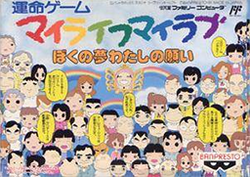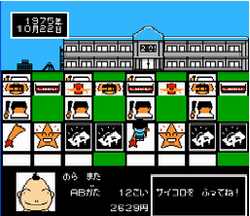- My Life My Love: Boku no Yume: Watashi no Negai
-
My Life My Love: Boku no Yume: Watashi no Negai 
Cover artDeveloper(s) Winkysoft
Pandora Box[1]Publisher(s) Banpresto[1] Platform(s) Family Computer[1] Release date(s) Genre(s) Life simulation game, Board game[1] Mode(s) Single-player
Multiplayer (up to 4 players)Media/distribution 6-megabit cartridge My Life My Love: Boku no Yume: Watashi no Negai (マイライフマイラブ ぼくの夢わたしの願いボクノユメワタシノネガイ Mai Raifu Mai Rabu: Boku No Yume: Watashi No Negai, "My Life My Love: I Wish my Dream"[3]) is a video game for the Family Computer that simulates a traditional board game. It was released in 1991 to an exclusively Japanese market.
Contents
Summary
At the time of release, the suggested manufacturer's retail price of the game was 10,080 yen (roughly equivalent to $111.63 in 2010 American dollars).[2]
During the game, brief news reports are provided to create a historical backdrop to the game. A news anchorman and his assistant helps to cover important headlines including LSD becoming illegal and the release of Steven Spielberg's 1982 movie E.T. the Extra-Terrestrial. Watching a player grow up from a 5-year-old into an 18-year-old can take anywhere from 90-120 minutes (1½-2 hours) depending the ability of the player to make the right decisions on the virtual board. Pushing the B button brings out a text-based menu exclusively in Japanese. The player can use the menu to either save the game, end a friendship, end a romantic relationship, use an item, along with other things.
Gameplay
Character development
The first thing a player must do is to make a character. He/she creates the character by assigning his/her avatar some personality traits, a blood type, the avatar's gender, and the character's birth date information to conclude the questionnaire. Any date from January 1, 1950 to December 31, 1980 is valid. Otherwise, the player's character would either be too old (prematurely ending the game) or too young (causing the game to unnecessarily strain itself to accompany non-existent futuristic dates). The character's face is randomly created from all of these variables.[4] Rolling the dice is the first thing the player must do once placed on the gigantic virtual board.[4] After randomly throwing a number from one to six, the results of landing on a square either decreases or increases the character's virtual development statistics.[4]
These increases and/or decreases in statistics occur in the events that are played out and/or the choices that are given to the player. Consequences can even result in losing a turn if the "punishment" is severe enough. As the player progresses down the board, the date moves closer to 1991 where the game reaches its ultimate goal.[4] Players can establish friendships and even romantic relationships with non-player characters. The player who has developed his or her character to be either the strongest, the most intelligent, or with the most positive emotions wins the game.
Stages of development
Childhood and adolescence offer the most choices while adulthood is considered to be linear. Anime-style graphics are illustrated throughout the game and the game is entirely in the Japanese language. Players are also offered pets at random moments in their childhood; it could be a dog, a cat, or any other kind of domestic animal. Neglecting the animal lowers its affection points towards the player to the point that it will eventually die from starvation and/or abandonment. One of the player's parents (either the mother or the father) will hand out random monetary rewards to the player that will stop around early adulthood.
The faces of the player have a rather arbitrary form throughout the game. For example, the player will retain the childhood portrait until he or she turns thirteen. That is when the adolescent portrait of the character replaces the childhood portrait in a sudden manner. While it is simple to spot the difference between a male and a female if the player is familiar with the anime drawing style, it is rather odd for a 12-year-old with a child's face to suddenly become a 13-year-old with a young adult face right on his or her birthday. The same thing occurs when the player's character turns eighteen; the face turns from a high school student directly into an adult that is wearing business clothes. With this lack of insight in the development of a growing child's body, this game is not appropriate for dealing with the character's changes during puberty.
Even the faces and bodies of the player's friends and romantic partners will change as they reach the milestones (age 13, age 18, and so on). Clothing will evolve from children's clothing to school uniforms to business outfits and eventually into casual wear. The player's pets do not undergo change as they age; they start to decline instead until they die of old age.
References
- ^ a b c d e "Release information". GameFAQs. http://www.gamefaqs.com/console/nes/data/570580.html. Retrieved 2008-04-29.
- ^ a b "Release information reference #2 (Japanese)". Famitsu. http://www.famitsu.com/review/title/0000/0000/0001/5938/. Retrieved 2009-01-04.
- ^ "Japanese title". superfamicom.org. http://superfamicom.org/famicom/info/my-life-my-love-boku-no-yume-watashi-no-negai/. Retrieved 2008-04-29.
- ^ a b c d "Game Summary". NES Player. http://www.nesplayer.com/features/famicom/6.htm. Retrieved 2008-04-29.
External links
Categories:- 1991 video games
- Japan-exclusive video games
- Nintendo Entertainment System games
- Nintendo Entertainment System-only games
- Raising sims
- Social simulation video games
- Video games developed in Japan
- Video games set in the 1950s
- Video games set in the 1960s
- Video games set in the 1970s
- Video games set in the 1980s
- Video board games
- Winkysoft games
- Life simulation game stubs
- Video board game stubs
Wikimedia Foundation. 2010.

